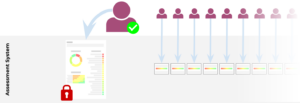Individual Sustainability Benefits Evaluation
Sustainability seems to come up almost everywhere you look at the moment, and the challenges the world is facing are obvious.
Everyone is being told to make sustainability a priority, but engagement and progress by organisations are lagging:

The Sustainability Benefits Evaluation addresses these challenges by getting you to think about sustainability in a complementary, new way that has been almost mostly totally absent in sustainability circles to date – how your organisation might directly benefit from sustainability:
Authentic Sustainability
that is truly
“sustainable”
how it works and what you’ll get
you will be sent an email with a unique link to click
Immediately after purchase, we will send you an email with the unique and secure link you’ll need to click to access your evaluation. We don’t recommend you use a mobile phone for this: the process is most effective when you can see a wider context on a bigger screen and can more easily type in comments.

you will be guided to securely access your response by setting a password
You will be prompted to set up a password that allows you to save and return to your evaluation at any time. After you have submitted your evaluation, this password allows you to access your ‘Response Report’. If you forget your password, you can click ‘forgotten password’ on the login screen to reset it.

you will be asked to read and evaluate 32 potential benefits of Sustainability
You will be presented with 32 potential benefits of Sustainability – organised into 5 tabbed sections (Risk Mitigation, Internal Improvements, New Opportunities, Market Profile and Intrinsic benefits). For each benefit, you will be asked to what extent it matters to your organisation, and to comment on specifically why and how. You will also be asked to enter any additional benefits that you value.

complete your evaluation and get your Response Report
Upon completion, you submit your evaluation and will be given a PDF report of your response to download, print or share. This report collates and analyses your evaluations, summarises key takeaways, and suggests how to use what you have learned.

Individual
For anyone with an interest in, or role related to, sustainability – try out a fresh new approach to sustainability to see how it might look in your organisation
Recommended Starting Point
Features include:
£175
excl. VAT
Recommended Next Step
All features of “Individual”, plus:
£1875
excl. VAT
* max 15 people per team
Organisation
For organisations ready to fully spread and scale sustainability – surface and channel everything needed to empower and embed vision and emergent best practice
Coming Soon
All features of “Team”, plus:
From £xxxxx excl. VAT
To purchase an evaluation or if your requirements are not supported by the available options
